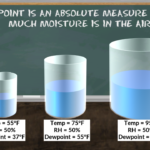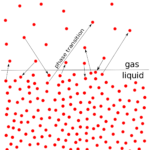Specific Volume is the volume that a certain weight of air occupies at a specific set of conditions. The specific volume of air is basically the reciprocal of air density. As the temperature of the air increases, its density will decrease as its molecules vibrate more and take up more space (as per Boyle’s law). Thus the specific volume will increase with increasing temperature.
Since warm air is less dense than cool air which causes warmed air to rise. This phenomenon is known as thermal buoyancy. By similar reasoning, warmer air has greater specific volume and is hence lighter than cool air.
The specific volume of air is also affected by humidity levels and overall atmospheric pressure. The more the moisture vapour present in the air, the greater shall be the specific volume. With increased atmospheric pressure, the greater the density of the air – so the lower its specific volume. The unit of measure used for specific volume is cubic feet/lb of dry air.
Specific volume is represented on Psychrometric Chart by lines that slant from the lower right hand corner towards the upper left hand corner at a steeper angle than the lines of wet bulb temperature and enthalpy.



